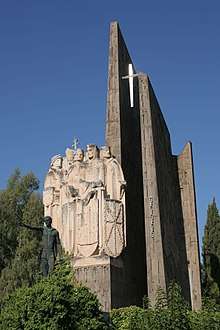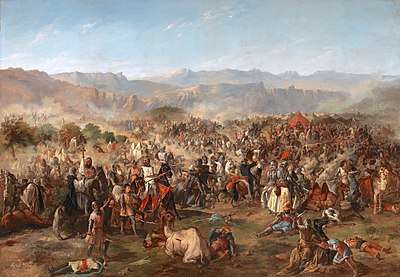Battle of Las Navas de Tolosa
The Battle of Las Navas de Tolosa, known in Arab history as the Battle of Al-Uqab (Arabic: معركة العقاب), took place on 16 July 1212 and was an important turning point in the Reconquista and in the medieval history of Spain.[7] The Christian forces of King Alfonso VIII of Castile were joined by the armies of his rivals, Sancho VII of Navarre and Peter II of Aragon, in battle[8] against the Almohad Muslim rulers of the southern half of the Iberian Peninsula. The al-Nasir (Miramamolín in the Spanish chronicles) led the Almohad army, made up of people from all over the Almohad Caliphate.
Background
In 1195, Alfonso VIII of Castile was defeated by the Almohads in the Disaster of Alarcos. After this victory the Almohads took several important cities: Trujillo, Plasencia, Talavera, Cuenca, and Uclés. Then, in 1211, Muhammad al-Nasir crossed the Strait of Gibraltar with a powerful army, invaded Christian territory, and captured Salvatierra Castle, the stronghold of the knights of the Order of Calatrava. The threat to the Hispanic Christian kingdoms was so great that Pope Innocent III called Christian knights to a crusade.
Battle
Alfonso crossed the mountain range that defended the Almohad camp, sneaking through the Despeñaperros Pass, led by Martín Alhaja, a local shepherd who knew the area. The Christian coalition caught the Moorish army at camp by surprise, and Alhaja was granted the hereditary title Cabeza de Vaca for his assistance to Alfonso VIII.

According to legend, the Caliph had his tent surrounded with a bodyguard of slave-warriors. Though it was once claimed that these men were chained together to prevent flight, it is considered more likely that this results from a mistranslation of the word "serried", meaning a densely packed formation. The Navarrese force led by their king Sancho VII broke through this bodyguard. The Caliph escaped, but the Moors were routed, leaving heavy casualties on the battlefield.[9] The victorious Christians seized several prizes of war; Muhammad al-Nasir's tent and standard were delivered to Pope Innocent III.[10]
Christian losses were far fewer, only about 2,000 men (though not as few as legend had it).[5] The losses were particularly heavy among the Orders. Those killed included Pedro Gómez de Acevedo (bannerman of the Order of Calatrava), Alvaro Fernández de Valladares (comendator of the Order of Santiago), Pedro Arias (master of the Order of Santiago, died of wounds on 3 August) and Gomes Ramires (Portuguese master of the Knights Templar and simultaneously master of Leon, Castile and Portugal). Ruy Díaz (master of the Order of Calatrava) was so grievously wounded that he had to resign his command.
Muhammad al-Nasir died in Marrakech shortly afterwards.
Aftermath
The crushing defeat of the Almohads significantly hastened their decline both in the Iberian Peninsula and in the Maghreb a decade later. That gave further impulse to the Christian Reconquest and sharply reduced the already declining power of the Moors in Iberia. Shortly after the battle, the Castilians took Baeza and then Úbeda, major fortified cities near the battlefield and gateways to invade Andalusia. According to a letter from Alfonso VIII of Castile to Pope Innocent III, Baeza was evacuated and its people moved to Úbeda; Alfonso laid siege, killing 60,000 Muslims and enslaving many more. According to the Latin Chronicle of Kings of Castile the number given is almost 100,000 Saracens, including children and women, who were captured.[11]
Thereafter, Alfonso VIII's grandson Ferdinand III of Castile took Cordova in 1236, Jaén in 1246, and Seville in 1248; then he took Arcos, Medina-Sidonia, Jerez, and Cádiz. In 1252, Ferdinand was preparing his fleet and army for invasion of the Almohad lands in Africa. But he died in Seville on 30 May 1252, during an outbreak of plague in southern Hispania. Only Ferdinand's death prevented the Castilians from taking the war to the Almohad on the Mediterranean coast, James I of Aragon conquered the Balearic Islands (from 1228 over the following four years) and Valencia (the city capitulated on 28 September 1238).
By 1252 the Almohad empire was almost finished, at the mercy of another emerging African power. In 1269 a new association of African tribes, the Marinids, took control of the Maghreb, and most of the former Almohad empire was under their rule. Later, the Marinids tried to recover the former Almohad territories in Iberia, but they were definitively defeated by Alfonso XI of Castile and Afonso IV of Portugal in the Battle of Río Salado, the last major military encounter between large Christian and Muslim armies in Hispania.
Moorish Granada
In 1292 Sancho IV took Tarifa, key to the control of the Strait of Gibraltar. Granada, Almería, and Málaga were the only major Muslim cities remaining in the Iberian peninsula. These three cities were the core of the Emirate of Granada, ruled by the Nasrid dynasty. Granada was a vassal state of Castile, until finally taken by the Catholic Monarchs in 1492.
In fiction
Harry Harrison's 1972 alternate history/science fiction novel Tunnel Through the Deeps depicts a history where the Moors won at Las Navas de Tolosa and retained part of Spain into the 20th century.
Notes
- Gitlitz, David Martin and Linda Kay Davidson, The Pilgrimage Road to Santiago, (St.Martin's Press, 2000), 60.
- Setton, Kenneth Meyer, A History of the Crusades, (University of Wisconsin Press, 1975), 423.
- Martín Alvira Cabrer: Las Navas de Tolosa, 1212: idea, liturgia y memoria de la batalla. Madrid 2012, p. 332
- Martín Alvira Cabrer: Guerra e ideología en la España medieval: cultura y actitudes históricas ante el giro de principios del siglo XIII: batallas de las Navas de Tolosa (1212) y Muret (1213). Universidad Complutense, Madrid 2000/2003. p. 196
- Gomez, Miguel Dolan, "The Battle of Las Navas de Tolosa: The Culture and Practice of Crusading in Medieval Iberia. " PhD diss.,University of Tennessee, 2011.
- Nafziger, 87.
- Lynn Hunt describes the battle as a "major turning point in the reconquista..." See Lynn Hunt, R. Po-chia Hsia, Thomas R. Martin, Barbara H. Rosenwein, and Bonnie Smith, The Making of the West: Peoples and Cultures: A Concise History: Volume I: To 1740, Second Edition (New York: Bedford/St. Martin's 2007), 391.
- Guggenberger, Anthony, A General History of the Christian Era: The Papacy and the Empire, Vol.1, (B. Herder, 1913), 372.
- According to the king of Castile, "On their side 100,000 armed men fell in battle..." See Lynn Hunt, R. Po-chia Hsia, Thomas R. Martin, Barbara H. Rosenwein, and Bonnie Smith, The Making of the West: Peoples and Cultures: A Concise History: Volume I: To 1740, Second Edition (New York: Bedford/St. Martin's 2007), 391.
- Riga and Rome: Henry of Livonia and the Papal Curia, Iben Fonnesberg-Schmidt, Crusading and Chronicle Writing on the Medieval Baltic Frontier, ed. Marek Tamm, Linda Kaljundi, Carsten Selch Jensen, (Ashgate Publishing, 2011), 224.
- "Three sources on the Battle of Las Navas de Tolosa in 1212 » De Re Militari". deremilitari.org. Retrieved 9 December 2017.
References
- Alvira Cabrer, Martín, Las Navas de Tolosa, 1212: idea, liturgia y memoria de la batalla, Sílex Ediciones, Madrid 2012 (Spanish).
- García Fitz, Francisco, Las Navas de Tolosa, Ariel, Barcelona 2005 (Spanish).
- García Fitz, Francisco, Was Las Navas a decisive battle?, in: Journal of Medieval Iberian Studies (JMIS), vol. 4, no. 1, 5–9.
- Nafziger, George F. and Mark W. Walton, Islam at War: a history, Greenwood Publishing Company, 2003.
- O’Callaghan, Joseph F., Reconquest and crusade in medieval Spain, University of Pennsylvania Press, Philadelphia PA 2004.
- Setton, Kenneth Meyer, A History of the Crusades, University of Wisconsin Press, 1975.
- Vara Thorbeck, Carlos, El lunes de las Navas, Universidad de Jaén, 1999. Re-edited with another title: Las Navas de Tolosa: 1212, la batalla que decidió la Reconquista, Edhasa, Barcelona 2012 (Spanish).
- https://web.archive.org/web/20150218025329/http://www.xenealoxia.org/linaxes/galicia/1451-valladares-marquesado-de.
- Gomez, Miguel Dolan, "The Battle of Las Navas de Tolosa: The Culture and Practice of Crusading in Medieval Iberia. " PhD diss.,University of Tennessee, 2011.
- http://www.lavozdegalicia.es/noticia/vigo/2014/12/14/casa-valladares-siglo-xvii-riesgo-desaparicion/0003_201412V14C4999.htm.
Further reading
- "Battle of Las Navas de Tolosa". Reader's Companion to Military History. Archived from the original on 26 February 2006. Retrieved 9 February 2006.
- (in Spanish) Martín Alvira-Cabrer, Las Navas de Tolosa, 1212. Idea, liturgia y memoria de la batalla, Sílex, Madrid, 2012. ISBN 9788477377214
